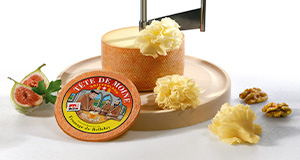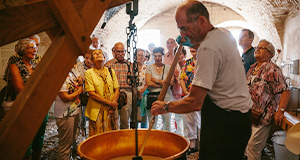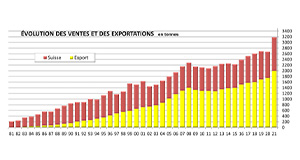"Tête de Moine" as a proper term has been used since about 1790, but the cheese has a much longer history.
The monastery of Bellelay was established in 1136 and confirmed by Pope Innocent II six years later. As early as 1192, or one century before the beginnings of the Swiss Confederation, the monks of the monastery Bellelay were first mentioned in connection with cheese. At that time they paid the annual rent on various properties with cheese made in their abbey. Time and again documents from subsequent centuries mention the use of the valuable cheese as a means of payment.
© Photo : Archives de l'ancien Evêché de Bâle
The oldest description of the Bellelay cheese dates from 1628 and states that a "very fat milk of impeccable quality from the best grasses and herbs of the country is used".
© Photo : Archives de l'ancien Evêché de Bâle
During the French Revolution the monks were evicted from the monastery in 1797, but the cheese was still produced in the cheese dairies of the former abbey. By the mid-19th century a farmer from Bellelay, A. Hofstetter, succeeded in boosting production anew when his cheese received awards at the "Concours Universel" of Paris in 1856 and at other trade fairs.
Towards the end of the 19th century several village cheese dairies were established. About 10 tons of Tête de Moine AOP were exported to countries as far away as Russia.
© Photo : Musée jurassien d'art et d'histoire, Delémont
At the beginning of the 20th century the making of the cheese gradually shifted from the farms to the village dairies, and by 1950 the annual production had increased to 27,000 kg.
The founding of the cheese trade organisation in the seventies and the invention of the «Girolle®» in 1981 (by Nicolas Crevoisier) marked another turning point in the history of Tête de Moine AOP, with 1'560 tons produced in 1999.
Beuret and Chatelain report that, in 1192, the cheese made in the abbey served as an annual fee paid in lieu of rent to the feudal tenure "Étoile". Over the centuries, mountain farmers began to make these cheeses outside the abbey, for example the Embreux dairy farm (between Les Genevez and Lajoux), the farms at Lajoux and at Genevez, as well as other farms tied to the abbey such as Les Joux, Fornet-Dessous, Rebévelier, ...
Places of production in 1950: Châtelat, Fornet-Dessous, Le Fuet, Lajoux, Moron, Reconvillier, Tavannes, Tramelan, Loveresse, La Chaux d'Abel, Le Noirmont, Villeret and the Courgenay cheese dairy.
"Bellelay cheese" was renamed towards the end of the 18th century as "Tête de Moine". The first mention in the archives of the Department of Mont-Terrible - the area had been annexed by the French and converted to a "département" - dates from around 1793-1799. It is a print entitled: "Tableau du maximum des objects de première nécessité" ("A comprehensive list of the primary necessities").
Version 1:
Nickname from the revolutionary period (comparison between the shaving of the cheese and a monk's tonsure).
Version 2:
In the Jura tradition has it that the cheese was stored in the abbey, counted per "monk's head". Hence the name "Tête de Moine".
These days, the prevailing designation for the cheese is "Tête de Moine".
© Photo : Musée jurassien d'art et d'histoire, Delémont












